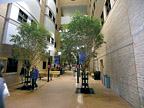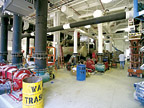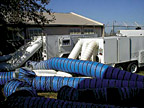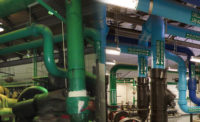
Whether it's a planned equipment changeout, an increased temporary load, an equipment failure, scheduled maintenance procedures requiring a shutdown of cooling systems, or a natural disaster, portable air conditioners, also referred to as "spot coolers," can fill a crucial role. Additionally, they can serve as permanent cooling systems for small-to-medium sized equipment centers, such as telephone systems or server rooms, and more.
Portable Cooling Keeps Key Research Progressing
When a new central chiller plant was slated to replace an existing system, staff at the University of Michigan faced some formidable challenges in maintaining HVAC service to key campus buildings. The North Campus of The University of Michigan in Ann Arbor continues to grow with new and updated facilities designed to help the university continue as one of the leading educational and research centers in the world.One of the many ambitious projects is the addition of a central chiller plant to replace the existing chillers found at most of the individual buildings on campus. The new chiller plant, being built by The Walbridge Aldinger Company and consisting of three 1,300-ton Trane chillers, will help the university realize tremendous savings in efficiencies and maintenance. "As with any project of this size and scope the going is not always easy and it is filled with many obstacles and surprises," explained Mark Henry, vice president of Mobile Air, Inc.
One such obstacle materialized when the Electrical Engineering & Computer Science Building and the adjoining Dow Laboratory Building were scheduled for the new chiller transitional piping to be tied into the existing system. The four-story, 100,000-sq-ft facility is the daily work environment for hundreds of students, researchers, and faculty containing a variety of labs, classrooms, offices, server rooms, and atrium areas.
The project was planned to be completed over the 2004 Christmas break in order to minimize classroom disruption. This, however, is not an average facility. Inside, research on leading-edge technologies in a variety of scientific disciplines takes place.
As a result, many research experiments can't take a winter break, nor can the researchers and teaching assistants who oversee and administer the high-tech experiments. And most critical to this particular project, the cooling to these areas could not be interrupted. "There were four areas of particular concern where we absolutely needed to maintain the ambient environment with temporary cooling," said Colin Murphy, mechanical engineer with the university.
Portable temporary cooling is not a daily requirement for an engineer like Murphy, so he contacted Henry at Mobile Air, Inc. "Upon reviewing the requirements firsthand I could see that different types of units would be required for each area to accomplish the job," said Henry.

Not Your Typical Icebox
The first area of concern was a laboratory where proteins are developed and stored for use in medical and chemical experiments. The proteins are stored in what appears to be a typical chest freezer. However, this freezer is designed to achieve the lowest possible temperatures, so that the molecular structure of the proteins nearly stop and are therefore preserved. The cost of recreating these proteins is in the millions of dollars."What we needed to do here was cool the condenser of the freezer to prevent the freezer from going off on high pressure during the shut down," said Murphy. "One issue typical of laboratories is that they are a sealed environment, with no way to vent out the condenser air from a typical portable air cooled unit," noted Henry. Fortunately, laboratories are normally equipped with several sinks or other water and drain sources.
Heat removal was accomplished using a 1.5-ton water cooled unit manufactured by OceanAire, Inc. Using a temporary condenser water hose kit, the unit is easily connected to the water and drain source. A 115V circuit is all that was needed to power the 1.5-ton unit and it was a very effective method of keeping the freezer condenser from overheating.
A second area was also cooled using OceanAire Water Cooled Units. This laboratory features equipment used to create thin layers of semi-conductive material used in electronic nanotechnology, where amazing miniaturization of electronics is created. In this instance the heat load was a little greater, so two 2-ton units were used. "The job could have been accomplished with a single unit; however, the room was already wired with 20-amp, 220V, one-phase circuits, so using the two 2-ton units made sense from an easy installation perspective," said Henry. Since a water and drain source was readily available, the installation was simple.
The third area was an office that was converted to a small server room housing several racks of servers requiring a total of four tons of cooling. This room was in a separate area of the building from the laboratories. The area above the drop ceiling, though not a true return air plenum, did have an opening to an adjacent area, which was a true return air plenum. "A return air plenum is an ideal place to vent condenser air from portable air cooled units," said Henry.
In the server room, plenty of power was available as long as it was 120V. For this room, four Classic Plus 14 Movincool Units manufactured by Denso Sales of California, Inc., were used. The units were installed quickly using condenser ceiling kits, and the space in this server room was cooled.

No Easy Access
The final area which required cooling was again computer related. This 2,500-sq-ft room is jam-packed with row after row of electronic and computer equipment of varying sophistication, from basic servers to high-powered processors used for extensive computations that are required for much of the research taking place in the building. This room is normally cooled by two 15-ton Liebert systems which were going offline due to the piping changeover.This room presented some challenges. The most obvious was that there was very little free space in the room. "You need to be careful walking in the room much less trying to cram 30 tons of cooling units in the space," said Murphy. Next, the room was an interior room with no easy access to an outside opening. "The one thing that was in our favor was that the room had a large double door opening, which opened to a wide hallway," he added.
A plan was devised to use three 12-ton air cooled units placed in the hallway outside of the room. The supply and return air would be brought into the room through one of the existing doorways. Just above the computer room was the mechanical penthouse. A chase located between the computer room and the hallway was used to run the power cord to the penthouse where plenty of three-phase power was available.
A VFD is used to control the condenser fan, allowing for a 0°F degree low ambient operation. However, in this application the VFD allowed the units to operate at a low noise level. Because the temperature in the hallway was a relatively cool 69°, the VFD spun the fan slowly, creating little fan noise, said Henry.
In order to prevent a buildup of excessive heat from the condenser within the hallway, additional fans were used to help direct the air down hallways and mix it with the general building air. Since this project took place in the winter months, taking the heat out of the computer room and adding that heat to the rest of the building was a benefit rather than a hindrance.
Staying Cool In The Zone
When the sports channel ESPN decided to set up an ESPN Zone on the bottom floor of a Manhattan highrise, portable cooling was required to keep the heavily lit set comfortable. The makeshift studio was designed for several months of use, but since it wasn't a permanent addition to the building, permanent cooling didn't make sense.To that end, Spot Coolers was called into the project to provide a 12-ton unit to handle the job. The 1,000-lb machine was rolled in on 8-in. casters and set up behind a wall that framed the 60-by 40-ft studio.
"The 12-ton unit is great, because it allows you to duct supply and return air long distances. We have large fan motors on the unit, so you can put over 100 feet of duct on the supply and return ports. This means you can put the unit relatively far away from the room or the application and still provide cool air and pull heat out of the space," said Garth Tagge, vice president of Spot Coolers.
In this particular application, the unit was not that far away from the studio, so the supply air was ducted into the room and the return air was pulled out of the room by cutting holes in the dividing wall. Being a television studio set, it was necessary to keep equipment noise to a minimum. The wall helped mask some of the sound, but more needed to be done.

No Air Noise ‘On The Air'
A 12-ton unit provided 4,800 cfm via a 14-in. hose, which in turn has two supply hoses, each delivering 2,400 cfm per hose. "They had to slow the air down to get rid of the air noise. To do that, they took the supply hoses and split them off so they had two 14-in. hoses coming off each 14.-in. hose. Then they put in a tee, and that slowed the air down, which reduced any noise from the airflow," Tagge said.This particular job was a challenge because the building was older, and there was not much room to stage the equipment. Another challenge was how to handle the heat rejection. "We actually ducted the hot air into what was apparently an elevator shaft that didn't have an elevator in it," Tagge added. "That shaft wasn't operational, and it went up to the roof. It was a pretty good-sized vent to take the heat and duct it up in there, and it didn't back up. That's how we got rid of the heat."
Usually in a temporary situation, such as a 12-ton unit in an office building, the only place to duct the hot air is into a stairwell or a mechanical room. "Getting rid of the heat is always a problem. The bigger the unit, the more heat you're transferring, and the bigger the problem becomes. In this case, it was just convenient that there was this shaft that was relatively close to the equipment, and with a 50-ft duct run, we were able to get rid of that heat," said Tagge. The condensate was just pumped to a sink.
Chillin' On Island Time
When Hurricane Ivan battered the Cayman Islands with 150-mph winds in September 2004, the devastation was massive. Homes were flooded, power was lost, roofs were ripped off of several buildings, and trees were toppled.Entech Sales & Service got a call from general contractor, Interstate Restoration, with whom Entech had worked in the past, asking for some help in the Caymans. One of the most important temporary cooling projects on Grand Cayman was the Governor's Residence.
"We had a lot of equipment available because it was the end of the season, and we responded right away. Within five to ten days, we had people on the job and they were assessing the situation and waiting for equipment," recalled Pat Rucker, Entech president.
On his flight to the island, Tom Steffen supervisor of Entech's Rental Equipment Division noted that over Florida, "Blue tarps dotted the landscape days after the hurricane, but in Grand Cayman, if you had a tarp on your roof three months later, you were fortunate." "The island itself was a mess. If you looked out at the ocean you saw true paradise; if you turned and looked inward you wanted to try to forget where you were," Steffen recalled.
The company had multiple jobsites on the island, but its highest priority was the Governor's Residence. Portable generators and air conditioning units were specified for this site. "The governor was entertaining dignitaries in the evenings, and there was not a lot of room for error on our part," Steffen said.

A Bit Different From The States
Once staff was onsite, the first of many challenges appeared when they had trouble getting the equipment through customs. After overcoming difficulties in getting the proper form of payment for duty fees, the A/C units and generators were released, but then transportation complexities arose. "First there was only one forklift available for rent. It was going to be three to four days before we could get it, but by now, we were already used to this kind of delay," Steffen said.The next problem was that the flatbed wrecker they needed to transport the 25-ton A/C unit to the staging area would not be available for five days. When the forklift finally arrived with a crew of six workers, the Entech staff figured everything was looking good. That is, until they realized the forklift was too small to handle the unit. "Our unit needed to be lifted high enough to clear the roof of the residence. A counterbalance of six men was required. We piled everyone on the back of the forklift and took a scary ride until we were able to set the unit back down," Steffen explained.
The Entech staff soon found that things that are taken for granted in the United States are not necessarily a given in the Caribbean. Getting diesel fuel delivered to run generators and A/C units, for example, was one of the biggest problems. "We ran out of fuel often. The people we worked for had the island mentality of ‘maybe tomorrow it will arrive.' A disruption of service like this in the States will get you thrown off the job. In Grand Cayman, with only one fuel truck, this was acceptable," Steffen recalled.
But this was not acceptable for the Governor's Residence. While they managed to keep plenty of fuel on hand for the high-profile job, they still encountered some snags.
The Governor's Residence had an existing 12-ton package unit mounted on the ground. It carried 208V and was single-phase, and the units Entech brought were 460V, three-phase, 25-ton units. "We measured the space where the unit was sitting, and found we just had enough space for the larger unit, and that it need to be powered with a generator," said Scott Perry, manager of Entech's Rental Equipment Division.
The Waiting Game
"The manager of the residence was concerned about the noise and smoke of the generator, but we assured them that that need not be a concern using the Cummins Power rental generators," Perry added. The Public Works Department was supposed to send someone over to remove the old unit and haul it off, but they took more than three days to show up.The Entech and Interstate Restoration staffs removed the gas from the existing unit, disassembled it, and set it to the side for the Public Works Department to haul away. After dealing with the previously mentioned transportation issues, they got the unit in place and fired it and the generator up. Due to the oversized unit, they had to loop some of the supply air into the return and then balance some outside air into it to keep the coil from freezing up.
"We got the unit operating to where it was not freezing up and it was cooling the house," Perry added. "The house manager and the head chef were extremely pleased with our work. The comment was made to us that if we had not taken charge of the job, it would have not got done in time. They were extremely pleased with our work ethic, because on the island nothing gets done in a hurry." ES


